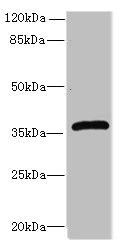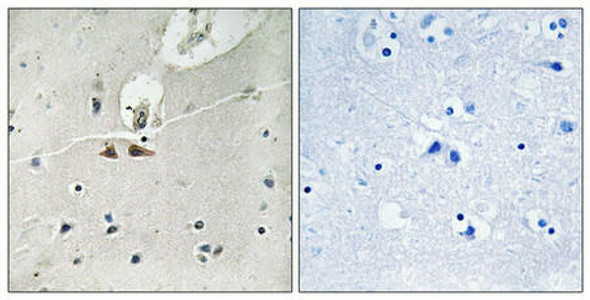Description
Efnb3 Antibody (PACO26405)
The EFNB3 polyclonal antibody (PAC026405) is an essential tool for researchers studying EFNB3, a key protein involved in neural development and synaptic plasticity. This antibody, produced in rabbits, exhibits high specificity and sensitivity towards EFNB3 in human samples, making it ideal for use in various research applications including Western blotting.EFNB3, a member of the ephrin family, is known to play a critical role in the development and function of the nervous system. It is involved in processes such as axon guidance, synaptogenesis, and synaptic plasticity, making it a valuable target for studies in neuroscience and neurodevelopmental disorders.
By using the EFNB3 polyclonal antibody, researchers can accurately detect and analyze EFNB3 protein expression in different cell types, providing valuable insights into its function and potential role in conditions such as neurodevelopmental disorders and neurological diseases. This antibody is an indispensable tool for those looking to further understand the intricate mechanisms underlying neural development and synaptic plasticity.
| Antibody Name: | Efnb3 Antibody (PACO26405) |
| Antibody SKU: | PACO26405 |
| Size: | 50ug |
| Host Species: | Rabbit |
| Tested Applications: | ELISA, WB |
| Recommended Dilutions: | ELISA:1:2000-1:10000, WB:1:1000-1:5000 |
| Species Reactivity: | Mouse, Human |
| Immunogen: | Recombinant Mouse Ephrin-B3 protein (28-227AA) |
| Form: | Liquid |
| Storage Buffer: | Preservative: 0.03% Proclin 300 Constituents: 50% Glycerol, 0.01M PBS, PH 7.4 |
| Purification Method: | >95%, Protein G purified |
| Clonality: | Polyclonal |
| Isotype: | IgG |
| Conjugate: | Non-conjugated |
 | Western blot All lanes: Efnb3 antibody at 12µg/ml + HepG2 whole cell lysate Secondary Goat polyclonal to rabbit IgG at 1/10000 dilution Predicted band size: 36 kDa Observed band size: 36 kDa . |
| Background: | Cell surface transmembrane ligand for Eph receptors, a family of receptor tyrosine kinases which are crucial for migration, repulsion and adhesion during neuronal, vascular and epithelial development. Binds promiscuously Eph receptors residing on adjacent cells, leading to contact-dependent bidirectional signaling into neighboring cells. The signaling pathway downstream of the receptor is referred to as forward signaling while the signaling pathway downstream of the ephrin ligand is referred to as reverse signaling. May play a pivotal role in forebrain function. Binds to, and induce the collapse of, commissural axons/growth cones in vitro. May play a role in constraining the orientation of longitudinally projecting axons. |
| Synonyms: | Ephrin-B3, Efnb3 |
| UniProt Protein Function: | EFNB3: Cell surface transmembrane ligand for Eph receptors, a family of receptor tyrosine kinases which are crucial for migration, repulsion and adhesion during neuronal, vascular and epithelial development. Binds promiscuously Eph receptors residing on adjacent cells, leading to contact-dependent bidirectional signaling into neighboring cells. The signaling pathway downstream of the receptor is referred to as forward signaling while the signaling pathway downstream of the ephrin ligand is referred to as reverse signaling. May play a pivotal role in forebrain function. Binds to, and induce the collapse of, commissural axons/growth cones in vitro. May play a role in constraining the orientation of longitudinally projecting axons. Belongs to the ephrin family.Protein type: Membrane protein, integral; Ligand, receptor tyrosine kinase; Cell development/differentiationCellular Component: integral to membrane; membrane; plasma membraneMolecular Function: ephrin receptor bindingBiological Process: adult walking behavior; axon choice point recognition; axon guidance; cell differentiation; ephrin receptor signaling pathway; multicellular organismal development; nervous system development; T cell costimulation |
| UniProt Protein Details: | |
| NCBI Summary: | |
| UniProt Code: | O35393 |
| NCBI GenInfo Identifier: | 6681281 |
| NCBI Gene ID: | 13643 |
| NCBI Accession: | NP_031937.1 |
| UniProt Secondary Accession: | O35393 |
| UniProt Related Accession: | O35393 |
| Molecular Weight: | 24 kDa |
| NCBI Full Name: | ephrin-B3 |
| NCBI Synonym Full Names: | ephrin B3 |
| NCBI Official Symbol: | Efnb3 |
| NCBI Official Synonym Symbols: | Epl8; EFL-6; ELF-3; Elk-L3; LERK-8; NLERK-2 |
| NCBI Protein Information: | ephrin-B3 |
| UniProt Protein Name: | Ephrin-B3 |
| UniProt Synonym Protein Names: | |
| Protein Family: | Ephrin |
| UniProt Gene Name: | Efnb3 |
| UniProt Entry Name: | EFNB3_MOUSE |











